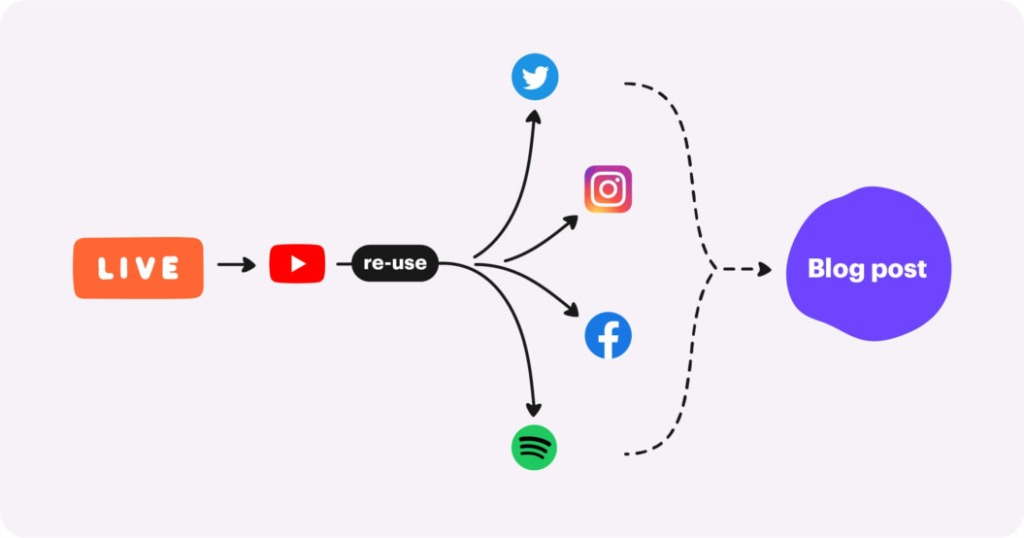Repurposing Content: The Ultimate Guide to Boosting Your Online Presence 2023
In this comprehensive guide, we will delve into the art and science of repurposing content to supercharge your online presence. While we understand that there are various factors affecting search rankings, our focus here is to provide you with the most valuable insights on repurposing content, so you can rise above the competition and claim the top spot on Google.

The Power of Repurposing Content
Repurposing content is a strategic approach that can significantly enhance your online visibility and SEO rankings. It involves taking existing content and adapting it into different formats or for various platforms. This approach not only saves time but also maximizes the value of your content.
Also Check Boosting Domain Authority and Dominating Search Rankings 2023
Why Repurpose Content?
Repurposing content offers several benefits:
- Diverse Content Types: By repurposing content, you can create diverse content types, including blog posts, infographics, videos, podcasts, and more. This caters to a broader audience with varying preferences.
- Improved SEO: Search engines favor fresh, relevant content. By repurposing and updating existing content, you keep your website active and appealing to search engine algorithms.
- Extended Reach: Different platforms have different user bases. Repurposing content allows you to reach new audiences across various channels, such as social media, YouTube, or industry-specific forums.
- Establishing Authority: Consistently providing valuable information across multiple formats establishes you as an authority in your niche.

The Repurposing Content Process
Now, let’s break down the steps to effectively repurpose your content and dominate the search results:
1. Content Audit
Begin by conducting a thorough content audit. Identify your top-performing pieces, evergreen topics, and content that needs updating. This will serve as your foundation for repurposing.
2. Choose Your Formats
Diversify your content by choosing suitable formats. Consider turning a well-performing blog post into an engaging video tutorial, an infographic summarizing key points, or a podcast discussing the topic in depth.
3. Optimize for Each Platform
Tailor your repurposed content to the platform you’re using. For instance, when repurposing for social media, craft catchy headlines and engaging visuals. On YouTube, optimize video descriptions and tags for SEO.
4. Keep It Fresh
Always update and refresh your repurposed content. Ensure that statistics, facts, and links are current. This signals to search engines that your content is up-to-date and relevant.
5. Cross-Promotion
Promote your repurposed content across all your channels. Share videos on social media, embed podcasts in relevant blog posts, and cross-reference content to maximize visibility.
Measuring Success
Measuring the impact of your repurposed content is crucial for refining your strategy. Utilize tools like Google Analytics to track changes in traffic, engagement, and conversions. Monitor keyword rankings to ensure your efforts are paying off.

Leveraging Keywords for Repurposing
Effective repurposing involves strategically using keywords to maintain SEO relevance. Here’s how you can do it:
1. Keyword Research
Before repurposing, conduct thorough keyword research to understand what your target audience is searching for. Tools like Google Keyword Planner and SEMrush can help identify relevant keywords and phrases.
2. Incorporate Keywords
Ensure that your repurposed content naturally incorporates these keywords. Use them in headings, subheadings, and throughout the content, but avoid overstuffing. Keyword placement should always enhance the readability of your content.
3. Optimize Meta Data
Don’t forget to optimize meta titles and descriptions. These elements play a significant role in click-through rates and SEO. Craft compelling meta titles that include your target keywords and provide a brief but enticing description of your content.
4. Internal Linking
Internal linking is a powerful SEO strategy. When repurposing content, identify opportunities to link to other relevant pages on your website. This not only improves user experience but also helps distribute link equity throughout your site.

The Importance of Visual Content
In the digital landscape, visuals are essential. Incorporating images, infographics, and videos into your repurposed content can greatly enhance its appeal. Visual content not only makes your content more engaging but also contributes to SEO.
1. Image Optimization
When using images, ensure they are appropriately sized and optimized for web performance. Compress images to reduce load times and use descriptive alt text to improve accessibility and SEO.
2. Infographics
Create informative infographics summarizing key points from your content. Share them on platforms like Pinterest and include them within your articles. Infographics are highly shareable, increasing your content’s reach.
3. Video Integration
YouTube is the second-largest search engine globally. Convert your repurposed content into engaging videos and publish them on your YouTube channel. Optimize video titles, descriptions, and tags with relevant keywords for maximum exposure.

Mobile Optimization
Mobile optimization is no longer optional; it’s a necessity for SEO success. Ensure that your repurposed content is mobile-responsive to cater to the growing number of mobile users.
1. Responsive Design
Choose website themes and templates that are mobile-responsive. Test your content across various devices to guarantee a seamless user experience.
2. Page Speed
Page speed is a critical ranking factor. Compress images, use browser caching, and minimize JavaScript to improve loading times, both on desktop and mobile devices.
User Experience and SEO
User experience (UX) plays a vital role in SEO. Google rewards websites that provide excellent user experiences.
1. Readability
Ensure that your repurposed content is easy to read. Use short paragraphs, bullet points, and headings to break up text. This not only enhances SEO but also keeps users engaged.
2. Mobile-Friendly Navigation
Simplify navigation on your mobile site. Use easily accessible menus and optimize your site’s structure for mobile users.
Incorporating these SEO strategies into your repurposing efforts will help you outrank competitors and establish your brand as an authority in your niche. Remember, SEO is an ongoing process, so consistently monitor your performance, adapt to algorithm changes, and refine your strategy to maintain your dominance in the search rankings.
By following these advanced SEO techniques and staying ahead of the curve, you’re on the path to SEO success. Keep optimizing, and watch your website rise to the top of Google’s search results.
Here’s a FAQ (Frequently Asked Questions) section to address common queries related to content repurposing and SEO:

Q1: What is content repurposing, and why is it important for SEO?
A1: Content repurposing is the practice of taking existing content and adapting it into different formats or for various platforms. It is crucial for SEO because it allows you to maximize the value of your content, reach a broader audience, and signal to search engines that your content is up-to-date and relevant.
Q2: How does content repurposing help improve search rankings?
A2: Content repurposing improves search rankings by diversifying your content across various formats and platforms, appealing to different audience preferences. It keeps your website active, enhances user engagement, and increases your chances of ranking well on search engine results pages (SERPs).
Q3: What types of content can be repurposed?
A3: Virtually any type of content can be repurposed. Common examples include blog posts, videos, podcasts, infographics, webinars, and social media posts. The key is to adapt the content to suit the medium and audience.
Q4: How do I choose the right formats for repurposing?
A4: Select formats based on your target audience and the nature of your content. For instance, if you have a data-rich blog post, consider creating an informative infographic. If your content is instructional, transform it into a video tutorial. Understand your audience’s preferences and adapt accordingly.
Q5: Can repurposed content negatively affect SEO?
A5: Repurposed content should not negatively affect SEO if done correctly. Always ensure that repurposed content is unique and valuable in its own right. Avoid duplicate content issues by updating and customizing content for each platform or format.
Q6: How can I measure the success of my repurposed content?
A6: Use tools like Google Analytics to track changes in traffic, engagement, and conversions. Monitor keyword rankings for repurposed content to gauge its impact on SEO. Additionally, assess social shares, comments, and backlinks to evaluate its overall success.
Q7: Is keyword optimization important for repurposed content?
A7: Yes, keyword optimization is crucial for repurposed content. Conduct keyword research to identify relevant keywords and incorporate them naturally into your content. Optimize meta titles and descriptions, headings, and subheadings with target keywords for SEO benefits.
Q8: How can I make my repurposed content mobile-friendly?
A8: To make repurposed content mobile-friendly, choose responsive website themes, ensure images are appropriately sized and compressed, and minimize JavaScript. Test your content across various mobile devices to guarantee a seamless user experience.
Q9: Are there any best practices for improving user experience (UX) in repurposed content?
A9: Yes, for enhanced UX, use short paragraphs, bullet points, and headings to break up text. Simplify navigation on your mobile site, ensuring menus are easily accessible. A positive UX can boost SEO rankings by keeping users engaged and satisfied.
Q10: Is content repurposing a one-time effort, or should it be an ongoing strategy?
A10: Content repurposing should be an ongoing strategy. Regularly review and update your existing content to keep it relevant and maximize its value. Continuously adapt to changing trends and audience preferences to maintain SEO success.
These FAQs provide insights into content repurposing and its significance in SEO. If you have any further questions or need personalized advice, feel free to reach out to our team of SEO experts.
Optimizing Podcast SEO for Top Google Rankings 2023
In the ever-evolving digital landscape, podcasting has emerged as a powerful medium for sharing knowledge, stories, and entertainment. However, simply creating remarkable audio content isn’t enough; you need to ensure that your podcast episodes and related materials are discoverable by your target audience. This comprehensive guide delves into the strategies and techniques that will help you outrank competitors and secure the top spot on Google’s search results. Let’s explore how to optimize podcast SEO effectively.

1. Keyword Research and Integration
Choosing the Right Keywords: Your journey to higher Google rankings begins with meticulous keyword research. Identify relevant keywords that align with your podcast content. Tools like Google Keyword Planner and SEMrush can provide valuable insights into keyword popularity and competition.
Also Check Boosting Domain Authority and Dominating Search Rankings 2023
Long-Tail Keywords: While broad keywords have their place, long-tail keywords can be more effective in attracting a specific audience. These phrases are often less competitive and more likely to convert. Incorporate long-tail keywords naturally into your podcast titles, descriptions, and show notes.
2. High-Quality Podcast Show Notes
Detailed Show Notes: Crafting detailed show notes is a crucial step in optimizing podcast SEO. Include a comprehensive summary of each episode, covering key points, guest information, and any resources mentioned. This not only aids SEO but also enhances the user experience.
Transcriptions: Providing transcriptions of your podcast episodes can significantly boost your search engine rankings. Search engines can index the content within transcriptions, making it easier for users to find your podcast when searching for specific topics or keywords.
3. Optimize Podcast Titles and Descriptions
Compelling Titles: Your podcast episode titles should be captivating and descriptive. Use keywords naturally within titles while ensuring they accurately represent the content. Engaging titles can increase click-through rates and improve SEO.
Keyword-Rich Descriptions: The episode description is your opportunity to provide additional context. Craft keyword-rich, informative descriptions that entice users to listen. Avoid keyword stuffing, as this can have a negative impact on your rankings.
4. Consistent Content Schedule
Regular Updates: Search engines favor websites with fresh content. Maintain a consistent podcast release schedule to keep your audience engaged and attract new listeners. Regular updates signal to search engines that your podcast is active and relevant.

5. Quality Backlinks
Backlink Building: Building high-quality backlinks to your podcast website can significantly improve your SEO. Collaborate with other podcasters, bloggers, and industry influencers to secure backlinks. These endorsements enhance your website’s authority in the eyes of search engines.
6. Mobile Optimization
Mobile-Friendly Design: Ensure that your podcast website is mobile-friendly. Google prioritizes mobile-friendly websites in its search results. A responsive design improves user experience and can lead to higher rankings.
7. User Engagement and Reviews
Encourage Reviews: Positive user reviews and ratings can influence search engine rankings. Encourage your listeners to leave reviews on platforms like Apple Podcasts and Google Podcasts. Respond to reviews to build a loyal community around your podcast.
8. Performance Metrics
Analytics and Monitoring: Regularly monitor the performance of your podcast episodes using analytics tools. Identify which keywords are driving traffic, track user engagement, and adjust your strategy accordingly. This data-driven approach ensures continual improvement.
Conclusion
Mastering podcast SEO is an ongoing process that requires dedication and adaptability. By consistently implementing these advanced strategies, you’ll not only outrank your competitors but also build a strong online presence and a loyal listener base. Keep monitoring your performance, staying updated on SEO trends, and refining your approach, and your podcast will continue to rise in Google’s search rankings. Happy podcasting

Here are some frequently asked questions (FAQs) regarding podcast SEO optimization:
1. What is podcast SEO, and why is it important?
Podcast SEO refers to the strategies and techniques used to optimize a podcast’s online visibility and ranking in search engine results. It is essential because it helps podcasters attract a larger audience, increase discoverability, and outperform competitors in search rankings. Effective podcast SEO can lead to more listeners, improved brand visibility, and greater engagement.
2. How do I conduct keyword research for my podcast?
To conduct keyword research for your podcast:
- Use Keyword Research Tools: Tools like Google Keyword Planner, SEMrush, and Ahrefs can help you identify relevant keywords related to your podcast niche.
- Analyze Competitors: Study your competitors’ podcasts and websites to identify the keywords they are targeting. This can provide insights into potential keywords for your content.
- Consider Long-Tail Keywords: Long-tail keywords are specific phrases that are less competitive. Incorporate these into your podcast titles, descriptions, and show notes.
3. What are show notes, and why are they important for podcast SEO?
Show notes are detailed written summaries of your podcast episodes. They provide additional context, highlight key points, and include relevant links. Show notes are crucial for podcast SEO because they make your content more searchable and provide a rich source of information for both search engines and listeners.
4. How can I optimize podcast titles and descriptions for SEO?
To optimize podcast titles and descriptions for SEO:
- Include Keywords: Incorporate relevant keywords naturally into your titles and descriptions.
- Write Compelling Titles: Craft engaging and descriptive titles that accurately represent your content.
- Avoid Keyword Stuffing: While using keywords is essential, avoid overloading your titles and descriptions with keywords, as this can harm your SEO.
5. How can I build quality backlinks for my podcast website?
To build quality backlinks for your podcast website:
- Collaborate with Others: Partner with other podcasters and influencers in your niche for guest appearances or collaborations. Ensure they link back to your website.
- Guest Blogging: Write guest blog posts for websites in your industry and include links to your podcast episodes within the content.
- Shareable Content: Create compelling and shareable podcast episodes that encourage listeners to link to your content on their websites or social media.
6. What role does mobile optimization play in podcast SEO?
Mobile optimization is crucial because an increasing number of users access podcasts on mobile devices. A mobile-friendly website design ensures that your content displays correctly on smartphones and tablets, leading to a better user experience. Google also favors mobile-friendly websites in its search rankings.
7. How can I encourage user engagement and reviews for my podcast?
To encourage user engagement and reviews:
- Engage on Social Media: Actively engage with your audience on social media platforms and create a sense of community around your podcast.
- Ask for Reviews: Encourage your listeners to leave reviews and ratings on podcast platforms like Apple Podcasts and Google Podcasts.
- Respond to Feedback: Respond to listener comments and reviews, showing that you value their input and opinions.
8. What metrics should I monitor to track the success of my podcast SEO efforts?
To track the success of your podcast SEO efforts, monitor the following metrics:
- Traffic: Track the volume of traffic to your podcast website.
- Keyword Rankings: Monitor your rankings for target keywords on search engine results pages.
- Engagement: Measure user engagement metrics, such as time spent on your site and bounce rates.
- Backlinks: Keep an eye on the number and quality of backlinks to your website.
- Conversion Rates: Monitor conversion rates to understand how your podcast contributes to your overall goals, such as newsletter sign-ups or product sales.

These FAQs provide valuable insights into podcast SEO and how you can optimize your podcast for better search engine rankings and audience reach.
Boosting Domain Authority and Dominating Search Rankings 2023
In the competitive world of digital marketing, achieving a high Domain Authority (DA) is a critical factor for success. Your website’s DA not only influences your search engine rankings but also establishes your online credibility and authority in your niche. In this comprehensive guide, we will delve into the strategies and techniques you need to boost your Domain Authority and outshine your competitors in Google search results.

Understanding Domain Authority
Before we dive into the strategies, let’s clarify what Domain Authority is and why it matters.
Also Check SEO for Real Estate Websites 2023: Dominating Property Visibility
What is Domain Authority?
Domain Authority, often abbreviated as DA, is a metric developed by Moz that quantifies the authority and trustworthiness of a website’s domain on a scale from 1 to 100. The higher your DA score, the more likely your website is to rank well in search engine results pages (SERPs).
Why Does Domain Authority Matter?
- Search Engine Rankings: Websites with higher DA scores tend to rank higher in search engine results, driving more organic traffic.
- Credibility: A high DA signals to users and search engines that your website is a trustworthy source of information.
- Competitive Advantage: Outranking competitors becomes easier when your DA is higher.
Now that we’ve established the importance of DA, let’s explore the strategies to boost it.

Strategies to Boost Domain Authority
1. High-Quality Content Creation
Content is the foundation of your website’s authority. To improve your DA, focus on:
- Keyword Research: Identify relevant keywords with high search volumes and low competition.
- Content Relevance: Create informative, well-researched, and engaging content that addresses your audience’s needs.
- Regular Updates: Consistently update and refresh your existing content to keep it relevant.
- Linkable Assets: Develop content that naturally attracts backlinks from authoritative websites.
2. On-Page SEO Optimization
Optimizing your website’s on-page elements is crucial for both user experience and search engine rankings:
- Title Tags and Meta Descriptions: Craft compelling titles and descriptions with targeted keywords.
- Header Tags: Use header tags (H1, H2, H3, etc.) to structure your content and make it more readable.
- Keyword Usage: Integrate keywords naturally throughout your content.
- Mobile Responsiveness: Ensure your website is mobile-friendly for a better user experience.
3. Link Building
Building high-quality backlinks is a cornerstone of improving your DA:
- Guest Posting: Contribute guest posts to reputable websites in your niche.
- Internal Linking: Link to relevant internal pages within your content.
- Broken Link Building: Identify broken links on authoritative websites and offer your content as a replacement.
- Social Media Promotion: Share your content on social media platforms to attract more visitors and potential backlinks.
4. Technical SEO
Optimize your website’s technical aspects to enhance its search engine performance:
- Site Speed: Ensure fast loading times to improve user experience and rankings.
- XML Sitemap: Create an XML sitemap to help search engines crawl your site efficiently.
- SSL Certificate: Secure your website with HTTPS to boost trust and SEO rankings.
5. User Experience and Engagement
A positive user experience can indirectly impact your DA:
- Responsive Design: Ensure your website adapts to various screen sizes and devices.
- Low Bounce Rates: Create engaging content that keeps visitors on your site.
- Page Dwell Time: Encourage users to spend more time on your pages.
- Comments and Social Shares: Foster user engagement through comments and social media sharing.

Monitoring and Measurement
To gauge the effectiveness of your efforts, regularly monitor your website’s performance:
- Google Analytics: Analyze traffic sources, user behavior, and conversions.
- Backlink Audits: Keep track of your backlink profile and disavow toxic links.
- DA Checker Tools: Use tools like Moz, Ahrefs, or SEMrush to monitor your Domain Authority over time.
By implementing these strategies diligently, you can significantly improve your website’s Domain Authority and, in turn, outrank your competitors in Google search results. Remember that patience and consistency are key in the world of SEO, and as your DA grows, so will your online presence and authority. So, get started today and watch your website rise to the top of the rankings!
Content Promotion and Outreach
Creating exceptional content is just the first step. To maximize its impact on your DA and search rankings, you need to promote it vigorously:
- Email Outreach: Reach out to influencers and websites in your niche, sharing your content and seeking collaboration opportunities.
- Social Media Promotion: Share your content on various social media platforms and engage with your audience regularly.
- Content Syndication: Consider syndicating your content on reputable platforms to reach a broader audience.
- Online Communities: Participate in relevant online forums and communities, contributing valuable insights and linking to your content when appropriate.

Schema Markup and Rich Snippets
Implementing schema markup on your website can enhance your search results with rich snippets, making your listings more appealing and informative to users:
- Product Reviews: Add schema markup to display product ratings and reviews in search results.
- Events: If you host events, use schema markup to provide event details, dates, and locations.
- FAQs: Highlight frequently asked questions and answers directly in search results.
- Recipe Cards: For food blogs, enable recipe schema to display cooking times, ratings, and nutrition information.
Earning Featured Snippets
Featured snippets, also known as position zero, can significantly increase your website’s visibility in search results. To earn them:
- Provide Clear Answers: Structure your content to answer common questions concisely.
- Use Lists and Tables: Format content using lists and tables, as these are more likely to be featured.
- Featured Snippet Optimization: Identify keywords that trigger featured snippets and optimize your content accordingly.

Mobile-First Indexing
With Google’s shift towards mobile-first indexing, ensuring your website is mobile-friendly is paramount:
- Responsive Design: Ensure your website adapts seamlessly to different screen sizes and orientations.
- Mobile Page Speed: Optimize your website’s loading speed for mobile users.
- Mobile Usability: Test your site’s usability on mobile devices, addressing any issues promptly.
Voice Search Optimization
As voice search continues to grow in popularity, optimizing for voice queries can give you an edge:
- Natural Language Content: Create content that answers common voice search queries conversationally.
- Local SEO: Optimize for local voice searches by focusing on location-based keywords.
- Structured Data: Use schema markup to provide context for voice search results.
International SEO
If your target audience extends beyond borders, consider international SEO strategies:
- Hreflang Tags: Implement hreflang tags to signal to search engines which language and region your content targets.
- Localized Content: Create content tailored to specific regions and languages.
- Country Code TLDs: Consider using country-code top-level domains (ccTLDs) for international targeting.

Conclusion
Achieving a high Domain Authority (DA) and dominating search rankings is not merely a goal but a strategic imperative in the world of digital marketing. Your website’s DA serves as a beacon of authority, trustworthiness, and relevance in the eyes of both search engines and your audience.
This comprehensive guide has equipped you with a powerful arsenal of strategies and tactics, ensuring that your website not only competes but excels in the highly competitive realm of SEO. From content creation and promotion to technical optimizations, mobile responsiveness, and international reach, you now possess the knowledge to steer your online presence towards unparalleled success.
Remember, SEO is an ever-evolving landscape, and adapting to new trends and algorithm updates is crucial. Consistency, patience, and a commitment to delivering exceptional user experiences will propel your website to the forefront of search engine results.
The Impact of AI-Powered Chatbots on SEO 2023
AI-powered chatbots have had a significant impact on SEO (Search Engine Optimization) in several ways. SEO is the practice of optimizing websites to improve their visibility and ranking on search engine results pages (SERPs). Chatbots, powered by artificial intelligence, can influence SEO in both positive and negative ways:

- Improved User Experience (UX):
- Chatbots can enhance user experience by providing immediate responses to user queries, offering personalized recommendations, and guiding visitors through websites more efficiently. This leads to lower bounce rates, longer session durations, and increased user engagement, all of which are favorable signals to search engines.
Also Check The Synergy of UX Design and SEO 2023: A Winning Combination
- Lower Bounce Rates:
- When chatbots engage visitors and provide relevant information, it reduces bounce rates. Bounce rate is a metric that measures how quickly users leave a website after arriving. A lower bounce rate can indicate to search engines that your site offers valuable content and a good user experience.
- Increased Dwell Time:
- Chatbots can keep users on a website longer by providing real-time interactions and answers to their questions. Longer dwell times can positively impact SEO because they signal to search engines that your content is engaging and valuable.
- Keyword Optimization:
- Chatbots can analyze user queries and interactions to identify popular keywords and phrases. This data can be used to optimize content, meta tags, and other on-page SEO elements to better match the language and intent of your audience.
- Chatbots can analyze user queries and interactions to identify popular keywords and phrases. This data can be used to optimize content, meta tags, and other on-page SEO elements to better match the language and intent of your audience.

- Content Suggestions:
- AI-powered chatbots can suggest topics or content ideas based on user inquiries. This can help website owners create relevant and valuable content that aligns with user interests and search trends.
- Local SEO:
- Chatbots can assist with local SEO efforts by providing location-specific information to users, such as store hours, directions, or inventory availability. This is especially beneficial for businesses with physical locations.
- Voice Search Optimization:
- As voice search becomes more prevalent, chatbots can adapt to conversational queries and help websites optimize for voice search. Voice search queries tend to be longer and more conversational, and chatbots can provide insights into the kind of questions users are asking.
- Data Collection and Analytics:
- Chatbots can collect user data and feedback, which can be valuable for SEO analysis. Understanding user behavior and preferences can inform SEO strategies and content creation.
However, it’s important to note that chatbots can also have negative impacts on SEO if not implemented correctly:
- Overuse of Chatbots:
- Overloading a website with intrusive chatbots or poorly designed chatbot interactions can lead to a negative user experience, potentially increasing bounce rates and harming SEO.
- Content Duplication:
- If chatbots generate content that is duplicated across multiple pages, it can lead to duplicate content issues, which can negatively affect SEO rankings.
- Technical Issues:
- Poorly implemented chatbots can result in technical issues that slow down a website or cause errors, which can harm SEO performance.

- Natural Language Processing (NLP) for SEO:
- AI-powered chatbots leverage Natural Language Processing to understand and respond to user queries in a more human-like manner. This aligns with Google’s focus on understanding the context and intent behind search queries. As search engines increasingly favor content that matches user intent, chatbots can help websites create content that aligns better with user needs.
- Mobile Optimization:
- Many users access websites through mobile devices, and chatbots can be optimized for mobile platforms. This mobile-friendly experience can contribute to better SEO rankings because search engines prioritize mobile-friendly websites in their rankings.
- 24/7 Availability:
- Chatbots provide round-the-clock customer support and information access. This ensures that users can engage with your website at any time, which can lead to increased organic traffic and better SEO performance, especially if your competitors do not offer the same level of accessibility.
- Reduced Click Depth:
- Chatbots can quickly direct users to relevant pages or content, reducing the number of clicks required to find information. This can improve the overall site structure and make it easier for search engines to crawl and index your content, positively impacting SEO.

- User Feedback and Iteration:
- Chatbots can collect user feedback and identify pain points or areas for improvement on your website. By addressing these issues, you can create a better user experience, which can lead to higher rankings on search engine results pages.
- Rich Snippets and SERP Features:
- Chatbots can provide structured data and information that can be used to generate rich snippets in search results. Rich snippets, such as reviews, FAQs, and event listings, can increase click-through rates and enhance the visibility of your content on SERPs.
- Competitive Advantage:
- Implementing AI-powered chatbots early can give your website a competitive advantage. As more businesses adopt this technology, being an early adopter can help you establish authority in your niche and gain higher search rankings.
- However, it’s essential to monitor and analyze the performance of chatbots continually. Regularly review analytics data to ensure that chatbots are positively impacting user engagement and SEO metrics. Additionally, keep up with SEO best practices and search engine algorithm updates to adapt your chatbot strategies accordingly.

Conclusion
AI-powered chatbots have the potential to significantly impact SEO by improving user experience, optimizing content, and providing valuable insights. When implemented correctly and used to enhance user satisfaction, chatbots can contribute to higher search engine rankings and increased organic traffic to your website.
FAQ: The Impact of AI-Powered Chatbots on SEO
1. What is an AI-powered chatbot?
- An AI-powered chatbot is a computer program that uses artificial intelligence and natural language processing to engage in conversations with users. These chatbots can provide information, answer questions, and perform tasks autonomously.
2. How do AI-powered chatbots affect SEO?
- AI-powered chatbots can impact SEO in several ways. They can improve user experience, reduce bounce rates, increase dwell time, optimize content, and provide valuable data for SEO analysis.
3. How do chatbots improve user experience?
- Chatbots can enhance user experience by providing immediate responses to user queries, offering personalized recommendations, and guiding visitors through websites more efficiently. This leads to lower bounce rates and increased user engagement.
4. Can chatbots reduce bounce rates?
- Yes, chatbots can reduce bounce rates by engaging visitors and providing relevant information. A lower bounce rate is a positive signal to search engines, indicating that your site offers valuable content and a good user experience.
5. How do chatbots optimize content for SEO?
- Chatbots can analyze user queries and interactions to identify popular keywords and phrases. This data can be used to optimize content, meta tags, and other on-page SEO elements to better match user intent.
6. Are there any potential drawbacks to using chatbots for SEO?
- Yes, if chatbots are overused, poorly implemented, or generate duplicated content, they can harm SEO efforts. It’s important to implement chatbots thoughtfully and monitor their performance.
7. Can chatbots help with local SEO?
- Yes, chatbots can assist with local SEO efforts by providing location-specific information to users, such as store hours, directions, or inventory availability.
8. How do chatbots impact voice search optimization?
- Chatbots can adapt to conversational queries and help websites optimize for voice search. They can provide insights into the kind of questions users are asking, which is valuable for voice search optimization.
9. Are there any best practices for implementing chatbots for SEO?
- Some best practices include ensuring a seamless user experience, avoiding overuse of chatbots, monitoring user feedback, and regularly analyzing data to make improvements.
10. What should I consider when implementing chatbots for my website’s SEO strategy? – Consider your target audience, the type of content you provide, and the specific goals you have for your chatbot. Tailor the chatbot’s capabilities and interactions to align with your SEO objectives.
11. How can I measure the impact of chatbots on my website’s SEO? – You can measure the impact of chatbots on SEO by tracking metrics such as bounce rates, dwell time, click-through rates, and keyword performance. Additionally, monitor changes in organic traffic and rankings over time.
12. Is it important to stay updated on SEO trends when using chatbots? – Yes, it’s crucial to stay updated on SEO trends and search engine algorithm changes. Chatbot strategies should be adaptable to align with the latest SEO best practices.
This FAQ provides an overview of the impact of AI-powered chatbots on SEO and addresses common questions related to their implementation and benefits. If you have more specific questions or need further information, feel free to ask.
SEO for Real Estate Websites 2023: Dominating Property Visibility
In the ever-evolving digital landscape, the success of your real estate website hinges on its visibility in search engine results. SEO (Search Engine Optimization) plays a pivotal role in ensuring that your properties receive the attention they deserve. In this comprehensive guide, we will unlock the secrets to propel your real estate website to the top of Google’s search results, outperforming the competition.

Understanding the Real Estate SEO Landscape
Keyword Research: The Foundation of Success
Keyword research is the bedrock of any successful SEO strategy. Start by identifying the keywords and phrases potential homebuyers and sellers are likely to use when searching for properties. Utilize tools like Google Keyword Planner to unearth high-traffic, low-competition keywords specific to your market.
Also Check Dominating YouTube SEO 2023: Strategies for Higher Rankings
Crafting Engaging, SEO-Optimized Content
Content is king in the realm of SEO, and for real estate websites, it’s no different. Create informative, engaging, and user-friendly content that caters to the needs of your audience. Incorporate your chosen keywords naturally into your content to signal to search engines that your site is relevant to users’ queries.
Optimizing Meta Titles and Descriptions
Meta titles and descriptions are your website’s first impression on search engine users. Craft compelling and keyword-rich meta titles and descriptions to entice clicks. Ensure they accurately reflect the content of your webpages, fostering user trust and satisfaction.
Mobile Optimization: A Must
With an increasing number of users browsing on mobile devices, ensuring your website is mobile-friendly is paramount. Google prioritizes mobile-friendly websites in its rankings, so invest in responsive design to capture this growing audience.

Link Building: Building Authority and Trust
High-Quality Backlinks
Building a robust backlink profile is critical for SEO success. Seek high-quality backlinks from authoritative real estate websites, local directories, and relevant blogs. These backlinks not only drive traffic but also signal to search engines that your website is a trusted source.
Internal Linking Strategy
Internal linking is often overlooked but can significantly impact your SEO efforts. Link relevant pages within your site to help users navigate and discover more content. This also spreads authority throughout your website, improving its overall SEO health.
User Experience: The Cornerstone of SEO
Page Speed Optimization
Slow-loading pages can deter users and harm your rankings. Compress images, enable browser caching, and utilize content delivery networks (CDNs) to ensure your website loads swiftly.
Clear Navigation
A user-friendly navigation structure is crucial. Organize your website logically, making it easy for visitors to find properties, contact you, and access essential information.

The Power of Local SEO
Google My Business Optimization
For real estate professionals, local SEO is paramount. Optimize your Google My Business profile with accurate business information, high-quality images, and client reviews. This will improve your visibility in Google’s Local Pack and Maps results.
Local Content Creation
Create content tailored to your local market. Highlight neighborhood profiles, market trends, and local amenities to establish yourself as an authority in your area.
Measure, Analyze, and Adapt
Comprehensive Analytics
Utilize robust analytics tools like Google Analytics and Google Search Console to monitor your website’s performance. Track your organic search traffic, user behavior, and keyword rankings. This data empowers you to make informed decisions and refine your SEO strategy.
Ongoing Optimization
SEO is an ongoing process. Continuously monitor your website’s performance and adapt to changes in search engine algorithms and user behavior. Stay informed about industry trends and adjust your strategy accordingly.

Leveraging Social Media for Real Estate SEO
Engage with Your Audience
Social media platforms such as Facebook, Instagram, and LinkedIn provide excellent opportunities to engage with your target audience. Share your content, showcase property listings, and actively participate in relevant groups and discussions. Building a strong social media presence can indirectly boost your website’s SEO by driving traffic and increasing brand visibility.
Encourage Social Sharing
Make it easy for visitors to share your content on social media by integrating social sharing buttons on your website. When users share your content, it can lead to more backlinks and increased exposure, ultimately improving your SEO ranking.
Harnessing the Power of Video Marketing
Create Property Tours
Video is a compelling medium in the real estate industry. Create virtual property tours and upload them to platforms like YouTube. Optimize video titles and descriptions with relevant keywords, and include links back to your website in the video description. Videos not only engage users but also improve your website’s SEO by increasing its visibility on Google’s video search results.
Schema Markup for Real Estate
Rich Snippets
Implement schema markup on your real estate website to provide search engines with structured data about your properties. This can result in rich snippets in search results, showcasing property details, prices, and more. Rich snippets enhance your website’s visibility and attract more clicks from users.

Explore Paid Advertising
Google Ads
While organic SEO is essential, consider supplementing your efforts with Google Ads (formerly known as AdWords). Running targeted ad campaigns can place your website at the top of search results for specific keywords, providing immediate visibility to potential clients.
Content Updates and Freshness
Regularly Update Listings
Keep your property listings up-to-date. Expired or sold listings can harm your SEO, as they provide a poor user experience. Regularly audit and remove or update listings to ensure your content remains relevant and accurate.
Geographic Targeting
Micro-Targeting
If your real estate business operates in multiple regions or cities, create dedicated landing pages for each location. Tailor your content to address the unique needs and preferences of potential clients in those areas. This localized approach can significantly boost your SEO for specific regions.
User Reviews and Testimonials
Showcase Client Success Stories
Encourage satisfied clients to leave reviews and testimonials on your website or platforms like Google My Business. Positive reviews build trust and credibility, which can positively impact your SEO. Consider adding a “Testimonials” or “Success Stories” section to your website.
Security and HTTPS
Secure Sockets Layer (SSL)
Ensure your website is secure by implementing an SSL certificate. Google prioritizes secure websites in search results. This not only enhances your website’s SEO but also instills trust in visitors.

Conclusion
Achieving high rankings in Google search results for your real estate website requires a multifaceted approach. By following these advanced SEO strategies, optimizing your website for mobile users, and consistently producing high-quality, relevant content, you’ll position yourself as an authority in the real estate market. Stay vigilant, adapt to industry changes, and continually refine your SEO efforts to maintain and improve your rankings. With dedication and expertise, you can dominate the online real estate landscape.
The Synergy of UX Design and SEO 2023: A Winning Combination
In the ever-evolving landscape of digital marketing, the intersection of UX (User Experience) design and SEO (Search Engine Optimization) has emerged as a powerful force. We delve deep into the symbiotic relationship between these two critical elements, unraveling how they can work harmoniously to elevate your online presence and outshine competitors.

Crafting a Seamless User Experience
1. Enhancing Website Navigation Effective UX design starts with intuitive navigation. A well-structured website, with clear menus and logical pathways, ensures that visitors find what they seek effortlessly. This reduces bounce rates and keeps users engaged longer, a factor that search engines adore.
2. Mobile Optimization In today’s mobile-centric world, optimizing your site for mobile devices is paramount. Responsive design not only pleases users but also aligns with Google’s mobile-first indexing, potentially boosting your search rankings.
3. Speed Matters Slow-loading websites frustrate users and hurt SEO. Streamlining your site’s performance not only improves user experience but also aligns with Google’s ranking algorithms, where page speed is a crucial factor.
Also Check Dominating YouTube SEO 2023: Strategies for Higher Rankings
Content Is King, but Context Is the Kingdom
1. Keyword Research and Integration Effective SEO begins with meticulous keyword research. Identify relevant keywords that resonate with your audience and seamlessly integrate them into your content. Avoid keyword stuffing; instead, focus on creating valuable, informative content.
2. High-Quality, Engaging Content Content should be informative, engaging, and shareable. This encourages backlinks and social sharing, both of which can positively impact SEO rankings.
3. Schema Markup for Enhanced Visibility Utilizing schema markup enriches search results with additional information, making your content stand out. Google rewards websites that provide detailed, structured data.
User-Centric Design and SEO Strategies
1. Mobile-Friendly Content Design your content with mobile users in mind. Short paragraphs, concise headings, and engaging visuals ensure that your message reaches all users effectively.
2. Accessibility Matters Accessibility features, such as alt text for images and keyboard navigation, not only cater to diverse audiences but also align with Google’s inclusivity efforts.
3. A/B Testing for Continuous Improvement A/B testing allows you to refine UX design and SEO strategies. Continuously optimize your website based on user behavior and performance metrics.

The Marriage of UX Design and SEO in E-commerce
In the e-commerce realm, the synergy between UX design and SEO becomes even more critical. An intelligently designed website that prioritizes user experience can significantly boost sales. Here’s how:
1. Streamlined Checkout Process A seamless, user-friendly checkout process reduces cart abandonment rates, ultimately boosting conversion rates—a metric Google tracks closely.
2. Product Page Optimization Rich product descriptions, high-quality images, and user reviews not only enhance the user experience but also improve search engine rankings.
3. Mobile Shopping Experience Mobile optimization, coupled with a simplified shopping experience, ensures that potential customers can browse and make purchases effortlessly from their smartphones.
Maximizing the Benefits: Strategies for Success
Now that we’ve explored the fundamental principles of harmonizing UX design and SEO, let’s delve deeper into actionable strategies to ensure your website not only ranks higher on Google but also delivers an exceptional user experience.
1. Comprehensive Keyword Strategy
A robust keyword strategy is the cornerstone of successful SEO. Research and select keywords that align with your business goals and user intent. Tools like Google Keyword Planner and SEMrush can help identify high-impact keywords. Once you’ve identified these keywords, strategically incorporate them into your website’s content, meta descriptions, and headers. Remember, natural integration is key; avoid forced keyword stuffing.
2. User-Centric Content Creation
Quality content is essential. Craft content that not only satisfies search engine algorithms but also provides real value to your audience. In-depth, well-researched articles, blog posts, and product descriptions are more likely to attract organic traffic. Remember, your content should answer user queries comprehensively.
3. Optimized Visual Elements
Visual elements play a crucial role in user engagement. Optimize images and videos on your website to ensure they load quickly. Use descriptive alt tags for images to improve accessibility and SEO. Additionally, consider incorporating infographics, charts, and videos to make complex information more digestible and engaging for your visitors.

4. Site Architecture and Internal Linking
An organized site structure not only aids navigation but also helps search engines understand the hierarchy of your content. Ensure a clear and logical website architecture with categories and subcategories. Implement a well-thought-out internal linking strategy to guide users and search engine crawlers to relevant content. This not only enhances user experience but also distributes SEO value throughout your site.
5. Mobile-First Approach
Given the increasing prevalence of mobile users, adopting a mobile-first approach is imperative. Ensure that your website is responsive and mobile-friendly. Google prioritizes mobile indexing, so optimizing for mobile devices is non-negotiable for higher search rankings.
6. User Feedback and Continuous Improvement
User feedback is a goldmine of insights. Encourage users to provide feedback through surveys, comments, or contact forms. Analyze this feedback to identify pain points and areas for improvement in both your UX design and content. A website that evolves based on user input is more likely to meet user expectations and rank higher on search engines.
7. Social Signals and Backlinks
Engage with your audience on social media platforms. Sharing your content and encouraging social sharing can lead to increased visibility and backlinks, which are invaluable for SEO. High-quality backlinks from authoritative sources can significantly boost your website’s authority and trustworthiness in the eyes of search engines.

8. Regular SEO Audits
Perform regular SEO audits to identify and rectify any issues that might be hindering your website’s performance. This includes checking for broken links, optimizing meta tags, improving site speed, and ensuring proper indexing of your pages.
9. Local SEO Optimization
If your business serves a local audience, don’t underestimate the power of local SEO. Ensure your Google My Business listing is accurate and up-to-date. Encourage customer reviews and ratings. Local SEO can significantly improve your visibility in local search results.
10. Monitor, Analyze, and Adapt
Finally, continuously monitor your website’s performance using tools like Google Analytics and Google Search Console. Analyze the data, track keyword rankings, and assess user behavior. Use these insights to adapt your strategies, refine your content, and enhance the user experience continually.
Incorporating these strategies into your digital marketing efforts will not only help you outrank your competitors but also establish your website as a go-to resource for users in your niche. Remember, the synergy between UX design and SEO is an ongoing journey of refinement and optimization, and the rewards are well worth the effort.
Here are some frequently asked questions (FAQs) related to the synergy of UX design and SEO:

1. What is UX design, and how does it relate to SEO?
- User Experience (UX) design focuses on creating a seamless and enjoyable interaction between users and a website or application. SEO, on the other hand, is about optimizing a website to rank higher on search engines. The connection lies in providing a user-friendly experience that aligns with SEO best practices to improve search rankings.
2. How can I improve website navigation for better UX and SEO?
- To enhance website navigation, ensure clear and organized menus, use logical page hierarchies, and create user-friendly sitemaps. This not only improves the user experience but also helps search engines index your site effectively.
3. What are some key elements of mobile optimization for SEO and UX?
- Mobile optimization involves creating a responsive design that adapts to various screen sizes, optimizing page load times, and ensuring a mobile-friendly layout. Google prioritizes mobile-first indexing, making mobile optimization critical for both user satisfaction and SEO rankings.
4. How can I strike a balance between keyword optimization and user-centric content?
- Balancing keyword optimization and user-centric content is essential. Start by conducting thorough keyword research and then craft high-quality, informative content that naturally integrates these keywords. Prioritize delivering value to your audience while keeping SEO goals in mind.
5. What is schema markup, and how does it benefit both UX and SEO?
- Schema markup is a structured data format that provides search engines with additional context about the content on your website. It enhances search results by displaying rich snippets. This not only improves SEO by increasing click-through rates but also enhances the user experience by providing more relevant information.
6. How does A/B testing contribute to the synergy between UX design and SEO?
- A/B testing allows you to experiment with different website designs, layouts, and content to determine what resonates best with your audience. By continuously optimizing based on user behavior and performance metrics, you can improve both UX and SEO over time.
7. Can you explain the connection between e-commerce success and the synergy of UX design and SEO?
- In the e-commerce sector, a user-friendly website that ranks well on search engines is crucial for attracting and converting customers. Streamlined checkout processes, optimized product pages, and a mobile-friendly shopping experience all contribute to higher conversion rates and improved SEO rankings.
8. How do I ensure my website is accessible to all users while maintaining SEO performance?
- To ensure accessibility without compromising SEO, use alt text for images, provide keyboard navigation options, and adhere to WCAG guidelines. Google values accessibility, so these efforts align with SEO goals.
9. What role do social signals and backlinks play in the synergy of UX design and SEO?
- Social signals and backlinks are essential for SEO. Social sharing of your content can increase visibility, while high-quality backlinks from reputable sources enhance your website’s authority, both of which contribute to better search rankings and user trust.
10. Why is continuous monitoring and adaptation important in the synergy between UX design and SEO? – The digital landscape is dynamic. Continuous monitoring and adaptation allow you to stay current with user trends, search engine algorithm updates, and evolving industry standards.
This ensures that your website remains competitive and user-friendly while maintaining strong SEO performance.
Dominating YouTube SEO 2023: Strategies for Higher Rankings
In the competitive world of online marketing, mastering YouTube SEO is the key to driving more traffic to your videos and increasing your online presence. At Finest SEO Agency, we understand the importance of outranking your competitors and gaining visibility on the world’s second-largest search engine. In this comprehensive guide, we’ll share the most effective strategies to help you outrank your competition and secure top positions on YouTube’s search results.

Understanding the Power of YouTube SEO
Before diving into the strategies, let’s first understand why YouTube SEO is crucial for your online success. YouTube, with over two billion monthly logged-in users, is a goldmine for businesses and content creators alike. Properly optimized videos can not only attract more viewers but also boost your website’s overall SEO ranking.
Also Check Social Bookmarking on SEO 2023 : Exploring the Impact
Conducting Keyword Research
The foundation of any successful YouTube SEO strategy is thorough keyword research. Identifying the right keywords allows you to tailor your content to what users are actively searching for. Here’s how you can do it:
1. Utilize YouTube’s Search Suggestions
YouTube’s search bar provides valuable insights into popular search queries. Begin typing your primary keyword, and YouTube will offer suggestions based on user behavior. These suggestions can be a goldmine of keyword ideas.
2. Leverage Keyword Research Tools
Tools like Google’s Keyword Planner and third-party platforms such as SEMrush or Ahrefs can provide you with in-depth keyword data. Look for keywords with a high search volume and low competition to maximize your chances of ranking.
Crafting Compelling Video Titles
Your video title is your first opportunity to capture a viewer’s attention. It should be both enticing and keyword-rich. Here’s a winning formula:
1. Include Your Target Keyword
Incorporate your primary keyword naturally into the title. For example, if your video is about “DIY Home Decor,” your title could be “DIY Home Decor: Transform Your Space on a Budget.”
2. Keep it Concise
YouTube recommends keeping your titles under 60 characters to ensure they display correctly on all devices.

Writing Engaging Descriptions
A well-crafted video description not only informs viewers but also provides additional SEO opportunities. Here’s how to create an effective video description:
1. Start with a Hook
Begin your description with a concise and intriguing hook to encourage viewers to read more.
2. Use Keywords Strategically
Incorporate relevant keywords naturally throughout the description to signal to YouTube’s algorithm what your video is about.
3. Include Timestamps
Timestamps allow viewers to navigate your video easily. They also improve your video’s chances of appearing as a featured snippet in search results.
Optimizing Tags and Metadata
Tags are essential for categorizing your video and helping YouTube understand its content. Here’s how to optimize them:
1. Choose Relevant Tags
Select tags that are directly related to your video’s content. Include a mix of broad and specific tags.
2. Analyze Competitor Tags
Review the tags used by top-ranking videos in your niche and incorporate relevant ones into your videos.

Captivating Thumbnails
Thumbnails serve as the visual gateway to your video. A compelling thumbnail can significantly increase your click-through rate (CTR). Consider these tips:
1. High-Quality Imagery
Use high-resolution images that are relevant to your video’s content.
2. Add Text and Graphics
Overlay text or graphics to highlight key points or add intrigue.
Promote Engagement
YouTube’s algorithm favors videos that keep viewers engaged. Encourage interaction with these strategies:
1. Ask for Likes, Comments, and Subscriptions
Politely ask viewers to like your video, leave a comment, and subscribe to your channel.
2. Create Playlists
Group related videos into playlists to keep viewers on your channel longer.
Analyzing and Iterating
Consistently monitor your video’s performance using YouTube Analytics. Pay attention to metrics like watch time, audience retention, and click-through rate. Use this data to refine your content and SEO strategies for ongoing improvement

Staying Ahead of the Curve
In the dynamic landscape of YouTube SEO, staying ahead of the curve is paramount to maintaining your competitive edge. Here are some advanced tactics to further enhance your rankings:
1. Video Transcripts
Including transcripts in the video description or as a separate file not only improves accessibility but also provides YouTube’s algorithm with more textual data to understand your video’s content. This can lead to higher rankings for relevant search queries.
2. Collaborate with Influencers
Partnering with influencers in your niche can expose your content to a broader audience. When an influencer features your video on their channel or social media, it can result in increased views, likes, and subscriptions.
3. Harness the Power of Social Signals
Engage with your audience on social media platforms. Sharing your videos and creating discussions around them can generate social signals that indirectly impact your video’s ranking on YouTube.
4. Analyze Competitor Strategies
Regularly monitor your competitors’ content and SEO strategies. Identify what’s working for them and adapt similar tactics to your own videos. This can help you stay competitive and even surpass their rankings.
5. Optimize for Featured Snippets
Featured snippets are valuable real estate in search results. To increase your chances of being featured, provide concise answers to common questions related to your video’s topic. Use timestamps in your description to make it easier for viewers to find the information they need.

The Mobile Experience
As mobile devices continue to dominate online content consumption, optimizing your videos for mobile viewing is crucial. Ensure that your videos are mobile-friendly by following these guidelines:
1. Responsive Design
Use responsive video players that adapt to various screen sizes. This ensures a seamless viewing experience on both smartphones and tablets.
2. Mobile-Friendly Thumbnails
Create thumbnails that are visually appealing even on smaller screens. Test how they appear on mobile devices to guarantee clarity and impact.
3. Thumbnail Text Legibility
Keep thumbnail text concise and legible. Small screens may make long titles or text difficult to read.
YouTube Algorithm Updates
YouTube frequently updates its algorithm, which can impact your video’s ranking. Stay informed about these changes through official YouTube announcements and industry news. Be prepared to adjust your strategy accordingly to maintain or improve your rankings.
Final Thoughts
Mastering YouTube SEO is an ongoing process that demands continuous adaptation to the evolving digital landscape. By implementing the strategies outlined in this guide, you’ll be well-equipped to outrank your competitors on YouTube and establish a commanding online presence. Remember, success in YouTube SEO isn’t just about outranking others; it’s about providing value to your audience and fostering a dedicated community of viewers. Stay committed to creating high-quality, engaging content, and your rise in the YouTube ranks will follow suit. Good luck on your journey to YouTube SEO dominance!

Frequently Asked Questions (FAQs) – YouTube SEO
Q1: What is YouTube SEO, and why is it important?
A1: YouTube SEO, or Search Engine Optimization for YouTube, is the process of optimizing your videos and channel to rank higher in YouTube’s search results. It’s essential because it helps increase the visibility of your videos, attract more viewers, and grow your online presence.
Q2: How can I find the right keywords for my videos?
A2: To find the right keywords, start by using YouTube’s search suggestions and keyword research tools like Google’s Keyword Planner, SEMrush, or Ahrefs. Look for keywords with high search volume and low competition that are relevant to your video’s content.
Q3: What makes a good video title?
A3: A good video title should be concise, enticing, and include your target keyword. It should grab viewers’ attention and clearly convey what your video is about while staying under 60 characters for optimal display.
Q4: How should I craft an engaging video description?
A4: Craft an engaging video description by starting with a hook, using keywords strategically throughout, and including timestamps for easy navigation. Provide additional information about your video’s content and remember to keep it informative and concise.
Q5: What are the best practices for video tags and metadata optimization?
A5: When optimizing tags and metadata, choose relevant tags that directly relate to your video’s content. Analyze competitor tags for inspiration and include them if appropriate. Make sure your video file name, title, description, and tags all align with your target keyword.
Q6: Can you explain the importance of thumbnails in YouTube SEO?
A6: Thumbnails are crucial as they serve as the visual representation of your video. A compelling thumbnail can significantly increase your video’s click-through rate (CTR), which is an essential ranking factor. Use high-quality imagery, overlay text or graphics, and ensure it’s mobile-friendly.
Q7: How can I encourage viewer engagement on my videos?
A7: To encourage viewer engagement, ask viewers to like, comment, and subscribe in your video. Create playlists to keep viewers on your channel longer. Engage with comments and foster a sense of community among your audience.
Q8: What are featured snippets, and how can I optimize for them?
A8: Featured snippets are the highlighted answers or content that appear at the top of some search results. To optimize for featured snippets, provide concise and informative answers to common questions related to your video’s topic. Use timestamps to make it easier for viewers to find the information they need.
Q9: How can I stay updated with YouTube algorithm changes?
A9: Stay updated with YouTube algorithm changes by following official YouTube announcements and industry news. Join relevant forums or communities where professionals discuss updates and best practices. Be prepared to adjust your strategy as needed to adapt to algorithm changes.
Q10: Is YouTube SEO a one-time effort, or do I need to continuously optimize my content?
A10: YouTube SEO is an ongoing effort. To maintain or improve your rankings, you must continuously optimize your content, stay informed about algorithm changes, and adapt your strategy accordingly. Consistency and quality are key to long-term success in YouTube SEO.
If you have any more questions or need further assistance with YouTube SEO, feel free to reach out to us at [Your Contact Information].
Social Bookmarking on SEO 2023 : Exploring the Impact
In the ever-evolving landscape of digital marketing, staying ahead of the curve is paramount. Search Engine Optimization (SEO) is one such domain that requires constant adaptation to the latest trends and strategies. Today, we delve into the profound impact of social bookmarking on SEO. By the end of this comprehensive guide, you’ll not only understand the significance of social bookmarking but also discover how to leverage it effectively to outrank your competitors.

What is Social Bookmarking?
Before we plunge into the intricacies of SEO and social bookmarking, let’s establish a fundamental understanding of the concept. Social bookmarking refers to the practice of saving website links or URLs on a public platform, much like adding a webpage to your favorites. These bookmarks are usually stored online, making them accessible from any device with an internet connection.
Also Check The Significance of Customer Reviews in Local SEO 2023
Benefits of Social Bookmarking for SEO
1. Enhanced Website Visibility
- One of the primary advantages of social bookmarking is that it can significantly boost your website’s visibility on search engines. When you bookmark a webpage on a social platform, it creates a valuable backlink to your site. These backlinks are crucial for search engines like Google, as they view them as a vote of confidence in your content’s quality.
2. Increased Traffic
- Social bookmarking sites often have a large user base. When you share your content on these platforms, it has the potential to reach a broader audience. This increased exposure can lead to more organic traffic to your website, which is a positive signal for SEO rankings.
3. Improved Domain Authority
- Domain authority is a metric that search engines use to measure the trustworthiness and authority of a website. Social bookmarking can help improve your domain authority by generating quality backlinks. This, in turn, can positively impact your search engine rankings.
4. Faster Indexing
- Search engines regularly crawl popular social bookmarking websites. When you bookmark your content on these platforms, it can expedite the indexing process, ensuring that your web pages appear in search results more quickly.

Effective Strategies for Social Bookmarking
Now that we’ve established the benefits of social bookmarking for SEO, let’s explore some strategies to make the most of this powerful tool.
1. Choose the Right Platforms
- Not all social bookmarking sites are created equal. It’s essential to identify platforms that align with your niche and target audience. Popular choices include Reddit, Pinterest, and Digg. Ensure your profile on these platforms is well-optimized with accurate information and links to your website.
2. Create Compelling Descriptions
- When adding bookmarks, pay careful attention to the descriptions you provide. These descriptions should be concise, yet compelling, and include relevant keywords related to your content. Think of them as mini-advertisements for your webpage.
3. Engage with the Community
- Social bookmarking isn’t just about dropping links and leaving. Actively engage with the community by upvoting, commenting, and sharing other users’ content. Building a positive reputation within these platforms can amplify the impact of your own bookmarks.

Monitoring and Measuring Success
Understanding the effectiveness of your social bookmarking efforts is crucial for optimizing your SEO strategy. Here are some key metrics to monitor:
1. Traffic Sources
- Keep a close eye on your website analytics to track the sources of incoming traffic. You should see an increase in traffic from social bookmarking platforms as your efforts gain traction.
2. Backlink Quality
- Not all backlinks are created equal. Monitor the quality of backlinks generated through social bookmarking. High-quality backlinks from reputable platforms carry more weight in SEO.
3. Keyword Rankings
- Regularly check how your target keywords are ranking in search engine results pages (SERPs). A positive correlation between your social bookmarking efforts and improved rankings is a good sign.
4. Engagement Metrics
- Evaluate the engagement on your social bookmarking posts. Look at the number of likes, shares, and comments. Higher engagement indicates that your content is resonating with the audience.
5. Conversion Rates
- Ultimately, the success of your SEO efforts should be measured by conversions. Track how many visitors from social bookmarking sites convert into customers or subscribers.

Best Practices for Social Bookmarking
To maximize the impact of social bookmarking on SEO, consider these best practices:
1. Consistency is Key
- Social bookmarking should be a consistent part of your content promotion strategy. Regularly share valuable content to maintain visibility and engagement.
2. Diversify Your Content
- Don’t limit yourself to sharing only your own content. Sharing relevant and high-quality content from other sources can establish you as an authority in your niche.
3. Avoid Spammy Practices
- Be mindful of the communities you engage with. Spamming or over-promotion can lead to a negative reputation and hinder your SEO efforts.
4. Optimize Your Website
- Ensure that your website is well-optimized for SEO. High-quality content, fast loading times, and mobile responsiveness are all factors that can influence search rankings.
5. Stay Updated
- SEO and social media platforms are constantly evolving. Stay updated with the latest trends and algorithms to adapt your strategy accordingly.

Conclusion
Social bookmarking is a powerful tool in the realm of SEO. When used effectively, it can significantly enhance your website’s visibility, increase traffic, boost domain authority, and expedite indexing. By following the best practices outlined in this guide and consistently monitoring your progress, you can harness the full potential of social bookmarking to outrank competitors and secure a prominent position in Google’s search results.
Remember, success in SEO requires dedication and a holistic approach. Social bookmarking is just one piece of the puzzle, but when combined with other SEO strategies, it can propel your website to new heights of online visibility and success.
The Significance of Customer Reviews in Local SEO 2023
In the realm of digital marketing, where competition is fierce and online visibility is paramount, local SEO has emerged as a potent tool for businesses to thrive. While there are several elements that contribute to local search engine optimization, one aspect that plays an indisputable role in shaping a brand’s online presence is customer reviews. In this comprehensive guide, we delve into the pivotal role that customer reviews play in local SEO strategies and how harnessing their power can help your business soar to the top of search engine rankings.

Understanding Local SEO
Before we delve into the world of customer reviews, let’s briefly grasp the essence of local SEO. Local search engine optimization is the practice of optimizing a website to increase its visibility in local search results. It’s all about ensuring that when potential customers search for products or services in their vicinity, your business appears prominently in the search results. This is particularly vital for brick-and-mortar stores and local service providers.
Also Check Future of Keyword Research 2023: AI and Beyond
The SEO Landscape
To appreciate the significance of customer reviews in local SEO, it’s imperative to recognize the dynamics of modern SEO. Gone are the days when simply stuffing keywords into your website’s content could propel you to the top of search engine results pages (SERPs). Google and other search engines have become exceptionally adept at evaluating the overall user experience and the credibility of businesses. Here’s where customer reviews come into play as a compelling ranking factor.
Building Trust and Credibility
Customer reviews are akin to digital testimonials. When potential customers encounter your business online, they often seek reassurance from the experiences of others. Positive reviews act as a vote of confidence, assuring prospective clients that your business is reputable and trustworthy.

Keyword-Rich User-Generated Content
One of the unsung benefits of customer reviews is the treasure trove of keyword-rich content they provide. When customers leave reviews, they often naturally incorporate keywords related to your business, products, or services. Search engines reward websites that feature relevant and informative content, and customer reviews are a goldmine of such material.
Social Proof and Influence
In today’s digitally connected world, social proof carries immense weight. Customer reviews are a form of social proof that can sway potential customers’ decisions. Businesses with a plethora of positive reviews are more likely to convert visitors into customers. Moreover, these reviews can influence click-through rates and reduce bounce rates, both of which are essential for SEO.
Generating Fresh and Dynamic Content
Search engines adore fresh content. It indicates that your website is active and continually providing value to users. By encouraging customers to leave reviews, you ensure a steady stream of fresh, user-generated content that keeps your website relevant in the eyes of search engines.

Local SEO Benefits
Now, let’s break down how customer reviews specifically benefit your local SEO efforts:
Enhanced Local Pack Rankings
The coveted local pack, which appears above the organic search results, is a prime spot for businesses. Customer reviews are a crucial factor in determining which businesses make it into this coveted space. The more positive reviews your business accumulates, the higher your chances of securing a spot in the local pack.
Increased Click-Through Rates
Listings with star ratings from customer reviews tend to attract more clicks. Users are naturally drawn to businesses with high ratings, and this increased click-through rate signals to search engines that your business is relevant and deserves a prominent position in the SERPs.
Geographical Relevance
Customer reviews often mention specific locations, neighborhoods, or cities. This geographical information helps search engines understand the local relevance of your business, making it more likely to appear in location-based searches.
Encouraging Customer Reviews
Now that we’ve established the vital role of customer reviews in local SEO, it’s crucial to know how to encourage and manage them effectively:
Create a User-Friendly Review Process
Make it easy for customers to leave reviews on your website and on popular review platforms like Google My Business, Yelp, and Facebook. Streamlined review processes result in more reviews.
Ask for Reviews
Don’t be shy about asking satisfied customers to leave a review. A polite request can go a long way in garnering valuable feedback.
Respond to Reviews
Engage with your customers by responding to their reviews, both positive and negative. Addressing concerns and expressing gratitude for positive feedback demonstrates your commitment to customer satisfaction.

Leveraging the Power of Customer Reviews
Monitoring and Managing Reviews
To maximize the benefits of customer reviews, it’s essential to have a systematic approach to monitoring and managing them. Here’s a step-by-step guide:
- Set Up Alerts: Utilize tools and services that can send you notifications whenever a new review is posted about your business. This allows you to stay informed in real-time.
- Regularly Check Review Platforms: Make it a routine to check review platforms where your business is listed. Respond promptly to reviews, as this shows your commitment to customer engagement.
- Address Negative Reviews Gracefully: Negative reviews are inevitable. When you encounter one, respond professionally and courteously. Acknowledge the issue, offer a solution or an apology if necessary, and show a willingness to improve.
- Highlight Positive Reviews: Showcase your best reviews on your website and marketing materials. This not only boosts your credibility but also encourages more customers to leave positive feedback.
Implementing Structured Data Markup
Structured data markup, commonly known as schema markup, is a powerful yet underutilized tool in local SEO. It provides search engines with additional information about your business, enhancing the visibility of your reviews. Implementing structured data markup can lead to rich snippets in search results, where star ratings and review counts are prominently displayed. This can significantly increase click-through rates to your website.

Encouraging User-Generated Content
Apart from customer reviews, there are other forms of user-generated content that can boost your local SEO efforts. Encourage customers to share photos and videos related to their experiences with your business. These multimedia elements not only engage potential customers but also signal to search engines that your content is diverse and relevant.
Monitoring Competitor Reviews
In the ever-evolving landscape of local SEO, it’s crucial to keep an eye on your competitors. Analyze their reviews and ratings. Understand what they are doing well and where they fall short. Use this information to refine your own strategies and offer superior services.
The Future of Local SEO and Reviews
As we look ahead, it’s evident that the role of customer reviews in local SEO will continue to evolve. Machine learning and artificial intelligence algorithms are becoming increasingly proficient at gauging the sentiment and relevance of reviews. Businesses that adapt and harness these technological advancements will likely gain a competitive edge in the digital marketplace.
Conclusion
Customer reviews are not just an afterthought in local SEO; they are the linchpin that can elevate your business to new heights. By building trust, generating keyword-rich content, and leveraging social proof, you can not only outrank your competitors but also solidify your presence in the local search landscape. Embrace the power of customer reviews, and watch your business flourish in the ever-competitive world of local SEO.
Remember, in the digital era, your customers are not just buyers; they are your brand ambassadors. Their voices, as reflected in reviews, can make or break your online success. So, cultivate a culture of excellence, provide impeccable service, and encourage your satisfied customers to sing your praises online. The path to local SEO supremacy starts with them.

Frequently Asked Questions (FAQs) – The Role of Customer Reviews in Local SEO
1. What is local SEO, and why is it essential for businesses?
Local SEO, or local search engine optimization, is a digital marketing strategy focused on optimizing a business’s online presence to increase visibility in local search results. It is crucial for businesses because it helps them connect with potential customers in their geographical area, driving foot traffic and online sales.
2. How do customer reviews influence local SEO?
Customer reviews have a significant impact on local SEO. They build trust and credibility, provide keyword-rich content, enhance social proof, and generate fresh and dynamic content—all of which signal to search engines that your business is relevant and trustworthy. This, in turn, improves your search engine rankings.
3. Can negative reviews harm my local SEO efforts?
Negative reviews can potentially harm your local SEO efforts if they dominate your online presence. However, when handled professionally and courteously, negative reviews can be turned into opportunities to demonstrate your commitment to customer satisfaction. Responding to negative reviews and addressing concerns can actually enhance your reputation.
4. How can I encourage customers to leave reviews?
Encouraging customers to leave reviews requires a proactive approach. You can create a user-friendly review process on your website, ask satisfied customers to leave reviews, and utilize popular review platforms like Google My Business, Yelp, and Facebook. Additionally, excellent customer service and a memorable customer experience can naturally lead to more positive reviews.
5. What are structured data markup and how does it benefit local SEO?
Structured data markup, also known as schema markup, is a code that you can add to your website to provide search engines with specific information about your business. It enhances your online presence by enabling rich snippets in search results, which prominently display star ratings and review counts. This can increase click-through rates to your website.
6. Besides customer reviews, what other forms of user-generated content can improve local SEO?
In addition to customer reviews, encouraging users to share photos and videos related to their experiences with your business can enhance local SEO efforts. These multimedia elements not only engage potential customers but also signal to search engines that your content is diverse and relevant.
7. How can I monitor competitor reviews to improve my local SEO strategy?
Monitoring competitor reviews involves analyzing their reviews and ratings. Understand what your competitors are doing well and where they fall short. Use this information to refine your own strategies and offer superior services. Learning from your competitors can help you stay ahead in the local SEO game.
8. What is the future of customer reviews in local SEO?
The future of customer reviews in local SEO is likely to see advancements in machine learning and artificial intelligence. These technologies will become more proficient at gauging the sentiment and relevance of reviews. Businesses that adapt and leverage these advancements will likely gain a competitive edge in the digital marketplace.
9. How can I cultivate a culture of excellence to encourage positive customer reviews?
Cultivating a culture of excellence starts with providing impeccable service and experiences to your customers. Train your staff to prioritize customer satisfaction, actively seek feedback, and continuously improve your offerings. Encourage your satisfied customers to share their positive experiences online, thereby becoming brand ambassadors.
10. What is the key takeaway regarding customer reviews in local SEO?
The key takeaway is that customer reviews are not just a component of local SEO; they are the linchpin that can elevate your business’s online success. Embrace their power to build trust, generate keyword-rich content, and leverage social proof. Your customers’ voices can make a substantial difference in outranking competitors and solidifying your presence in local search results.
Future of Keyword Research 2023: AI and Beyond
In the ever-evolving landscape of digital marketing, staying ahead of the curve is crucial. At Finest SEO Agency, we understand the significance of optimizing your online presence, and one of the key components in achieving this is effective keyword research. In this comprehensive guide, we delve deep into the future of keyword research, exploring the role of Artificial Intelligence (AI) and its potential to revolutionize the way we approach SEO.

Understanding the Evolution of Keyword Research
Traditional Keyword Research Methods
In the not-so-distant past, keyword research primarily relied on manual processes. Marketers painstakingly compiled lists of keywords based on intuition, Google’s autocomplete suggestions, and rudimentary keyword tools. While this approach yielded some success, it lacked the precision and scalability required for today’s competitive online landscape.
Also Check Dominating the Google Answer Box: A Comprehensive Guide 2023
Enter AI-Powered Keyword Research
AI has ushered in a new era of keyword research. Advanced algorithms can now analyze vast datasets at lightning speed, providing insights that were previously unimaginable. Here’s how AI is transforming keyword research:
Harnessing the Power of AI in Keyword Research
1. Semantic Analysis
AI-driven tools employ sophisticated semantic analysis to understand the context and intent behind search queries. This goes beyond simple keyword matching, allowing you to target a broader range of relevant keywords and phrases.
2. Predictive Analytics
AI models can predict emerging trends and keywords by analyzing user behavior, social media discussions, and market dynamics. This enables you to anticipate and adapt to changing search patterns effectively.
3. Natural Language Processing (NLP)
With NLP, AI can dissect the meaning of search queries, even when they are phrased in conversational language. This is particularly valuable in the era of voice search, where users are more likely to use natural language.
4. Content Generation
AI-generated content is on the rise. It can help automate the creation of high-quality, keyword-rich articles, saving time and resources while maintaining content quality.

The Benefits of AI-Powered Keyword Research
1. Improved Targeting
By understanding user intent more accurately, you can tailor your content to precisely match what your audience is searching for, leading to higher engagement and conversion rates.
2. Enhanced Competitive Analysis
AI tools can analyze competitor keywords and strategies, allowing you to identify gaps and opportunities in your niche.
3. Scalability
AI can process vast amounts of data quickly, making it feasible to manage and optimize keyword strategies for large websites and extensive content libraries.
4. Real-time Insights
With AI, you can access real-time data, enabling you to adapt your SEO strategy on the fly in response to changing trends and user behavior.

Implementing AI-Powered Keyword Research in Your Strategy
To leverage AI effectively in your keyword research strategy, consider the following steps:
1. Invest in AI Tools
Explore AI-powered keyword research tools like [Your Recommended AI Tool], which can provide valuable insights and streamline your SEO efforts.
2. Stay Informed
Keep abreast of the latest developments in AI and SEO. Attend conferences, webinars, and workshops to ensure you’re up-to-date with the cutting-edge techniques.
3. Continuously Refine Your Strategy
Regularly analyze the performance of your keywords and adapt your strategy as needed. AI allows for constant refinement based on real-time data.
Conclusion
The future of keyword research is undeniably intertwined with AI technology. By harnessing the power of AI in your SEO strategy, you can gain a competitive edge in the ever-evolving digital landscape. Embrace AI-powered tools, stay informed, and continually refine your approach to keyword research. The future is here, and it’s time to seize the opportunities it presents. Stay ahead of the curve, and success in the digital realm will undoubtedly follow.

Here’s an FAQ section to address common questions about AI-powered keyword research:
Q1: What is AI-powered keyword research?
A1: AI-powered keyword research refers to the use of Artificial Intelligence and machine learning algorithms to analyze, identify, and recommend keywords for search engine optimization (SEO) purposes. It leverages AI’s capabilities to provide more accurate and data-driven keyword insights.
Q2: How does AI improve traditional keyword research?
A2: AI enhances traditional keyword research by offering advanced semantic analysis, predictive analytics, and natural language processing. This enables marketers to identify more relevant keywords, predict trends, and understand user intent better.
Q3: What are the benefits of AI in keyword research?
A3: AI offers improved targeting, enhanced competitive analysis, scalability, and real-time insights. It helps businesses create content that precisely matches user intent, stay ahead of competitors, manage large keyword strategies, and adapt to evolving trends.
Q4: Are AI-generated content and keyword research ethical?
A4: Ethical considerations are essential. Ensure that data privacy is maintained, biases in AI models are minimized, and transparency in AI operations is upheld. Responsible AI usage is crucial for ethical AI-generated content and keyword research.
Q5: What are the future trends in AI-powered keyword research?
A5: The future holds trends like voice search optimization, visual search, and an emphasis on improving AI-generated content quality. These trends will shape how businesses approach keyword research and SEO strategies in the coming years.
Q6: How can I start implementing AI in my keyword research strategy?
A6: Begin by researching and investing in AI-powered keyword research tools. Stay informed about AI and SEO developments, and continuously refine your strategy based on real-time data and insights provided by AI tools.
Q7: Is AI-powered keyword research suitable for all businesses?
A7: AI-powered keyword research can benefit businesses of all sizes and industries. It offers scalability and adaptability, making it a valuable tool for startups, SMEs, and large enterprises looking to optimize their online presence.
Q8: Can AI help with multilingual keyword research?
A8: Yes, AI can assist in multilingual keyword research by translating and adapting keywords for different languages and regions. This allows businesses to expand their reach globally and target diverse audiences effectively.
Q9: Is AI-generated content as effective as human-created content?
A9: AI-generated content has made significant strides in quality, but it depends on the specific AI model and use case. For some content types, AI-generated content can be as effective as human-created content, while for others, human input may still be necessary.
Q10: How do I stay updated on AI and keyword research trends?
A10: Stay informed by attending industry conferences, webinars, and workshops. Follow reputable blogs and news sources in the SEO and AI fields to keep up with the latest developments and best practices.
These FAQs provide insight into the world of AI-powered keyword research, helping you understand its importance, benefits, and ethical considerations.



